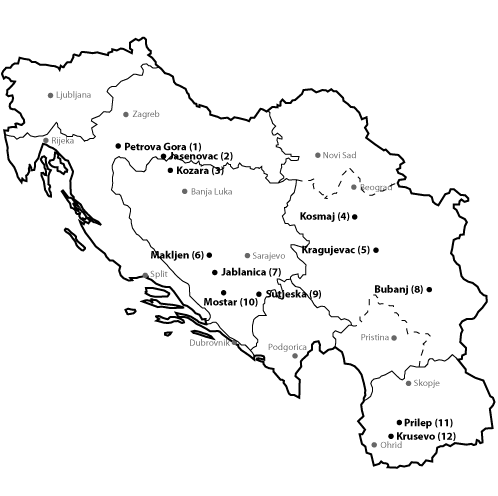Partisan Memorials in former Yugoslavia
by Robert Burghardt
A small slide show of partisan monuments on the territory of former Yugoslavia. Those monuments have an abstract, often monumental, but always unusual and peculiar formal vocabulary in common. They are located in the centre of Yugoslavian modernism, because they mark its starting point and they announce the modern outlook. In doing so, they still proclaim a future, which already has become past. They are expressions of this future and they refuse to stop epitomising its coming. They keep calling: Ahead! Spectres still inhabit the monuments, but their context, their audience has been lost.
Each monument name opens a slide show:
(01) Petrova Gora
(02) Jasenovac
(03) Kozara
(04) Kosmaj
(05) Kragujevac
(06) Makljen
(07) Jablanica
(08) Bubanj
(09) Sutjeska
(10) Mostar
(11) Prilep
(12) Krusevo
In the whole of Yugoslavia several thousand monuments and memorials have been raised, in the forties and fifties many still in the style of socialist realism, while the larger and most important memorial sites have been built from the beginning of the sixties. The selection here dates from the latter period, which followed the emancipation from the Soviet-Union and the development of Yugoslavia’s own road to socialism along the line of “self-management”. These monuments belong to the most important witnesses of Yugoslav memorial culture and stem from the most active period of Yugoslav modern art which has been described as socialist modernism or socialist aestheticism.
As War-monuments they are unique: They do not express the fighting and death, but life, resistance and the energy by which they were carried. They are directed forward while they mark the starting point for a new society, whose products they are.
In their abstract vocabulary they allow for an appropriation of meaning that bypasses official narrations, especially today, after their context has become invisible. They open the scene for numerous associations; they could be ambassadors from far-away stars, or from a different, unrealised present. The openness which originates in the abstract language of the monuments is a visual manifestation of the emancipation from the Stalinist dominance of socialist realism in the eastern bloc, in which future is represented only in a happy-overreaching form of the present. The monuments invoke a utopian moment, stick to aniconism, and translate the promise of the future into a universal gesture.

